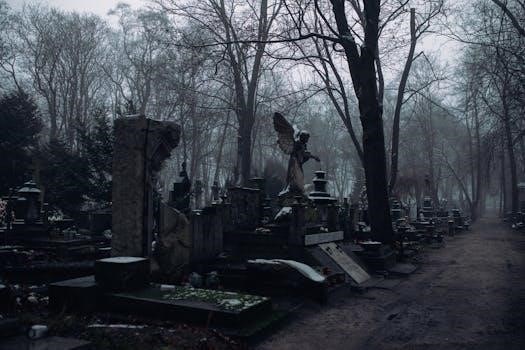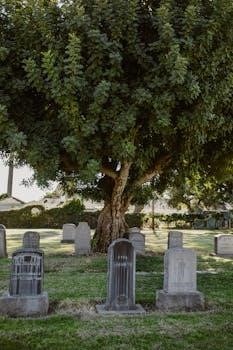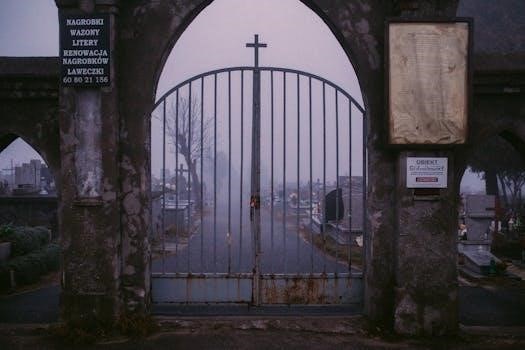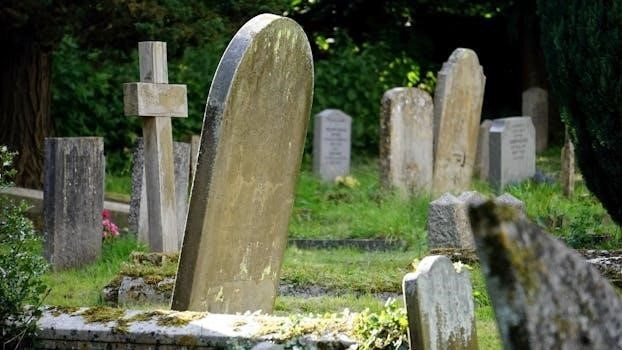death be not proud john donne pdf
John Donne’s “Death Be Not Proud,” also known as Holy Sonnet X, is a powerful metaphysical poem that directly confronts mortality. It challenges death’s perceived authority and explores Christian beliefs about eternal life. The poem is structured as a Petrarchan sonnet.
Overview of John Donne’s Holy Sonnet X
John Donne’s Holy Sonnet X, “Death Be Not Proud,” is a defiant exploration of mortality written in the form of a Petrarchan sonnet. The poem directly addresses death, personifying it as an arrogant figure to be challenged. It argues that death is not the powerful, dreadful entity it is often perceived to be. The sonnet presents a Christian perspective, suggesting death is merely a transition to eternal life. Donne employs strong language and imagery to assert the soul’s immortality over death.
Analysis of Death’s Personification
In “Death Be Not Proud,” Donne personifies death, treating it as a proud, arrogant being. This allows the speaker to directly challenge and belittle death’s perceived power through direct address.
Death as a Proud Figure
Donne’s poem opens by addressing Death directly, immediately establishing it as a personified entity. The speaker accuses death of being proud, despite its reputation for being “mighty and dreadful.” This personification presents death as an arrogant figure, a being that believes in its own insurmountable power over humans. The poem sets up a dramatic scene where the speaker will systematically dismantle this perceived pride.
Deflating Death’s Arrogance
The speaker actively works to deflate death’s arrogance by asserting that it is not as powerful as it believes. He argues that those death believes it “overthrows” do not truly die. Instead, death is presented as merely a temporary state, likened to rest and sleep, which offer pleasure. This undermines death’s power, showing it as something less fearsome than it is believed to be.

Thematic Exploration
The sonnet delves into mortality, confronting the fear of death. It also introduces the Christian concept of eternal life, where death is not an end, but a transition.
Mortality and the Fear of Death
John Donne’s poem directly tackles the human fear of death, which is a central theme. The speaker confronts death, personified as a proud entity, attempting to diminish its perceived power. The poem argues that death’s reputation as “mighty and dreadful” is undeserved, challenging the inherent dread people associate with it. By diminishing death’s power, the poem seeks to alleviate humanity’s anxiety regarding its own mortality.
Christian Belief in Eternal Life
Donne’s “Death Be Not Proud” also underscores the Christian belief in life after death, which provides a counterpoint to the fear of mortality. The poem suggests that death is not an end but rather a transition to eternal life, thus diminishing its ultimate power. This perspective aligns with the Christian understanding of death as a doorway to a higher existence. The work reframes death as a temporary state, not a finality, reflecting a key aspect of Christian theology.
Literary Devices
Donne employs several literary devices, notably apostrophe, directly addressing death as a person. He also uses metaphors to represent death, depicting it as a proud, yet ultimately powerless figure, enhancing the poem’s impact.
Use of Apostrophe
The poem’s opening line, “Death, be not proud,” immediately establishes the use of apostrophe, a figure of speech where the speaker directly addresses an absent or inanimate entity as if it were present and capable of understanding. This device allows Donne to engage with death as a personified opponent, setting up a dramatic and confrontational tone that permeates the entire sonnet. This direct address is a key element in the poem’s power and impact.
Metaphorical Representation of Death
Donne employs metaphor to depict death not as an omnipotent force, but as a vain and arrogant figure, much like a proud human being. He initially portrays death as powerful, echoing common perceptions, but then undermines this image. By comparing death to something less formidable, such as sleep, the poem challenges the conventional view of mortality. This metaphorical representation serves to diminish death’s status and power within the sonnet.

Structure and Form
“Death Be Not Proud” is structured as a Petrarchan sonnet, composed of fourteen lines. It is divided into an octave and a sestet, following a traditional rhyme scheme.
Petrarchan Sonnet Structure
The poem adheres to the Petrarchan sonnet form, characterized by its fourteen lines divided into two distinct parts⁚ an octave (the first eight lines) and a sestet (the final six lines). The octave typically presents a problem or question, while the sestet offers a resolution or reflection. In this sonnet, the octave presents death’s perceived power, and the sestet challenges it. The rhyme scheme is ABBAABBA CDECDE.
Interpretation of Key Lines
Key lines, such as “Death, be not proud,” directly address and challenge death; The phrase, “Die not, poor Death,” further diminishes death’s power. These lines reveal the speaker’s defiant tone and perspective.
“Death, be not proud…”
The opening line, “Death, be not proud,” immediately establishes the poem’s confrontational tone. It’s an apostrophe, directly addressing death as if it were a person. This line challenges the conventional view of death as mighty and dreadful. The speaker starts by dismissing death’s perceived power and arrogance, setting the stage for a detailed argument against its supposed dominance. It is a direct attack on death’s reputation.
“Die not, poor Death…”
The line “Die not, poor Death,” presents a striking paradox. It suggests that death itself is not immortal and can be defeated. This phrase diminishes death’s power further, portraying it as weak and pitiable. The speaker implies that death is not the end but a transition, thus diminishing its finality. This bold statement challenges the very notion of death’s ultimate authority and hints at its eventual demise.

The Speaker’s Attitude
The speaker adopts a defiant and confident tone, directly addressing death. He diminishes death’s power, portraying it as weak and not something to be feared. He asserts human dominance over death.
Defiant Stance Against Death
The speaker’s attitude in “Death Be Not Proud” is marked by a clear defiance. He directly confronts death, refusing to acknowledge its perceived power and might. This is evident from the opening line, where he commands death not to be proud. The speaker’s tone throughout the sonnet is one of challenge and resistance, demonstrating a bold stance against the common fear associated with mortality. This is not a lament but a forceful assertion of human resilience.
Asserting Human Mastery Over Death
In “Death Be Not Proud,” the speaker goes beyond mere defiance; he actively asserts human mastery over death. He diminishes death’s power by portraying it as a mere transition, like rest or sleep. The speaker argues that death is not the end, but a temporary state, thus challenging its ultimate authority. This assertion of human control is central to the poem, showcasing the belief that death is not a master, but a defeated servant.
Theological and Philosophical Arguments
The poem presents death not as an end, but as a transition to eternal life, a core Christian belief. It philosophically challenges death’s power, arguing it is a temporary state, not ultimate defeat.
Death as a Transition to Eternal Life
Donne’s sonnet frames death not as a finality, but as a passage to an eternal existence, aligning with Christian theology. The poem suggests that death is merely a temporary state, akin to sleep, from which one awakens to a greater reality. This view diminishes death’s power, portraying it as a necessary step towards everlasting life, rather than an end in itself. The Christian concept of resurrection is subtly implied, emphasizing triumph over death.
Challenging the Power of Death
The speaker directly confronts and belittles death, asserting its lack of true power. Donne’s poem diminishes death’s seemingly mighty and dreadful reputation. It argues that death is not the ultimate victor, but rather a slave to fate, chance, and even kings. The poem positions death as a temporary and ultimately powerless entity, subject to forces beyond its control. This defiance of death’s authority is a core theme of the sonnet, diminishing the fear it instills.

Conclusion
Donne’s “Death Be Not Proud” delivers a message of hope, asserting that death is not the end. It’s a defiant proclamation of faith, diminishing death’s power and promising eternal life.
The Poem’s Message of Hope and Defiance
John Donne’s “Death Be Not Proud” is ultimately a testament to hope, arguing that death is not the ultimate victor. The poem defies death’s perceived power, positioning it as a temporary state akin to sleep. It boldly asserts that death is powerless, subject to fate, and not something to be feared. Donne’s work emphasizes the Christian concept of eternal life, where death is merely a transition, thus offering comfort and reassurance to the faithful. This gives the poem a powerful message of defiance against mortality.
